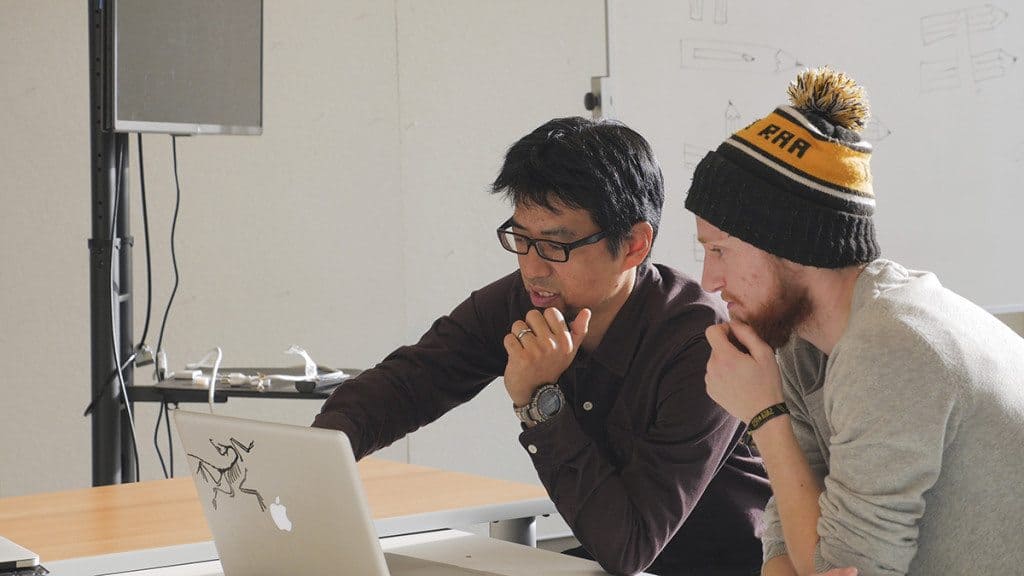An interview with Cornish Instructor, Junichi Tsuneoka
Junichi Tsuneoka is a pragmatic man. Whether he is creating posters for Kid Cudi concerts, ads for Adidas, or teaching courses on art and design, he is a man who is committed to process. The versatile founder of studio Stubborn Sideburn, Junichi is also an educator in the graphic design program at Cornish College of the Arts. This year he also created Introduction to Graphic Illustration, Kadenze’s first course on graphic design, and the first MOOC to be offered by Cornish College of the Arts.
As MOOCs continue to define their place at the table of higher learning, critics and champions alike have called into question both their effectiveness and their necessity as educational tools. Places like Youtube and Lynda.com have long been resources for students seeking tutorials on everything from Adobe Photoshop to JavaScript coding. With this in mind, it is important to ask: Why create a MOOC like “Introduction to Graphic Illustration” at all?
We recently sat down with Junichi Tsuneoka to ask him about that very question and the effects that online tutorials have had on modern illustrator/designers.

You mention, in your course, that we tend to have a very narrow view of Illustration. What do you mean by that and how would you like to see this change?
Well, I’m not sure that I’ve ever thought very hard about how I’d like things to change, and that’s because there are just so many different types of illustration in the world right now. The question to ask, I think, is how illustration is going to adapt to the available technology. With traditional illustration (like children’s book illustration for example) it doesn’t matter how you publish your work, the nature of that work remains the same. What you make as the illustrator remains the same: a 2D image that has been designed for a 2D medium, whether it’s published on paper or electronically.
On the other hand, nowadays we can start thinking in 3D. Take laser engraving for example. Laser engraving has only become common in the last few years, and because of it, we can basically create illustrations on any 3D surface. Before this technology existed, all we could think about printing on was paper. Now, you can design whatever you want on a computer, and because of the technology, somebody else can take it and then fabricate it for you. Somebody else can make it happen, and make it happen well.
The interesting thing is: when you start thinking about illustration in 3D, you have to also start thinking about the size and the proportions of the thing you are printing on. Then you have to adjust and design your illustration for that object specifically. This is the kind of thing that I am most excited about now, and it’s not just me. It’s becoming popular for a lot of people who are working in the field.
So I guess, to answer your question: What I’m looking for in the illustration world are new concepts and new technology that will make more room for anyone to start exploring this kind of work.
Do you think there is a hunger for this kind of illustration as a reaction to the fact that we tend to view a lot of things on screens these days?
I think so. But I’m not sure if that’s particularly new. Imagine that there is a good illustrator, because there have always been. Now, imagine that there is a good product designer, because there have always been. Before this moment, these had to be two different people. Because unless you could physically paint on a product (like a chair or a statue), then these two people could never exist as one person. Or rather, they could never produce a top-notch product AND a top notch illustration for that product. Because, traditionally, these two people think in two different dimensions; 2D and 3D.
Are you talking about branding?
No. Branding tends to be a marketing strategy. Branding is thinking about how to reach certain people in certain ways. Illustration and graphics are an aspect of this, but only one aspect. As an illustrator, I tend to function as a visual problem solver for brands. If somebody gives me a question, I can usually solve it visually. People who do marketing usually have a question for me, “I wanna do something like this. Can you do it?” Then my job is to provide some possible answers.
What I’m talking about is a new way to think about illustration. For example: If I do really cool graphics, I would love to look for someone that makes really unique chair designs (for example). Then, as an illustrator, I can think about what is the most effective way to put my graphics on that chair. What way compliments the chair and makes both better?

In your class, you talk a lot about digital tools like Adobe Photoshop or Illustrator. What effect do you think these tools have had on young illustrators?
Technology is tricky. Because of technology, the possibilities for illustration are expanding, but there is also a little bit of a misunderstanding about those digital tools and what they can actually do. The common perception is: if you learn the technology, then you can produce something. But I don’t think that’s the way to think. You still have to understand how to do the work yourself—without the aid of technology first. That way, you can use the technology to help make what you do better.
But to answer your question: because of the technology, the “how to” part of things or the idea part is getting kind of transparent now. People can see the whole illustration process more easily. For that reason, they tend to skip the fundamental theory-driven part, which is actually the most important part. What I was trying to say in my class is: understand how to make something first, then practice it. After that, you can use the technology available to enhance your idea all you like. Skip that first part and you can still produce work, but in the end, that work is going to suffer.
What do you think about all the online Photoshop tutorials on Youtube and Vimeo? Has that changed what students expect from design school? Has it changed how students value a classical education?
Oh man, that’s a hard question. What is most available on those sites and most easily accessed are materials that really focus on the production side of things. But these tools don’t actually teach you to make something well from the ground up. Like I said before, digital tools are best used to make something that you already have better. But you can’t make something from nothing with them. If you don’t have anything and you spend your time learning the tools that are designed only to make something better, then you’re basically not learning anything at all.
What do you wish all young designers/illustrators learned?
How to change their perspective. That will eventually lead them to what they need to know. The important thing is to start looking at things differently. Because visuals, illustration, and design are all around us. Everything you look at can teach you something. If you look at it and only think, “Wow, that’s cool,” then you don’t necessarily learn something from it. But once you change your perspective, you can see a candy wrapper on the street and still learn something from it.
When I was a student, everything I saw looked good to me, and that was partly because the examples people tend to show in school are examples of good work. But, once I started ingesting this stuff, I also became interested in the examples of bad illustration; the examples of bad design. I was interested in what made it bad—what mistakes were made—so that I could learn from them and not make the same mistakes myself. It’s perspective again, and it gives you the ability to realize what is working and what is not working.
That, in the end, is how we learn anything.
Introduction to Graphic Illustration is now open on Kadenze. Interested students are encouraged to sign up on Kadenze.com and start illustrating today.
To stay up-to-date on all future Kadenze announcement and blog stories, ‘like’ us on Facebook or follow us on Twitter @KadezeOfficial.
The post Learning to Illustrate in the Age of Youtube appeared first on Kadenze Blog.